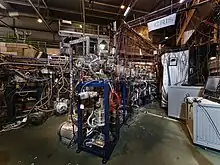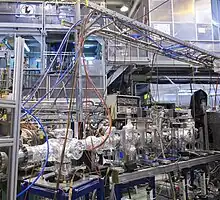| List of ISOLDE experimental setups | |
|---|---|
| COLLAPS, CRIS, EC-SLI, IDS, ISS, ISOLTRAP, LUCRECIA, Miniball, MIRACLS, SEC, VITO, WISArD | |
| Other facilities | |
| MEDICIS | Medical Isotopes Collected from ISOLDE |
| 508 | Solid State Physics Laboratory |

The Collinear Resonance Ionization Spectroscopy (CRIS) experiment is located in the ISOLDE facility at CERN. The experiment aims to study ground-state properties of exotic nuclei and produce high purity isomeric beams used for decay studies. CRIS does this by using the high resolution technique of fast beam collinear laser spectroscopy, with the high efficiency technique of resonance ionization.[1][2]
Background
The technique of fast beam collinear resonance ionization spectroscopy is a merger of two traditional approaches to laser spectroscopy: in-source resonance ionization spectroscopy and fluorescence-detection fast beam collinear laser spectroscopy.[3]
Resonance ionization spectroscopy is based on stepwise photo-ionization, which uses tunable lasers to match the laser light's photon energy to an atomic transition of an element. The photons will be resonantly absorbed if the light is incident on an atomic beam. By using a series of precisely tuned lasers, an electron will be excited through the energy level structure almost to the ionization potential of the element. The element can then be ionized to an autoionising state or non-resonant ionization state.[4][5] The technique allows for an elemental selectivity in ionization and isotopic selectivity in measurement, as other elements will not be affected by the tuned laser light.[6]
Fluorescence-detection fast beam collinear laser spectroscopy is a high-resolution technique that resolves the hyperfine structure and isotope shift of an atomic transition.[7] This is done by superimposing two beams, an ionic or atomic beam and a tuned narrow-bandwidth laser beam. At resonance, the beam is scanned and fluorescent photons are emitted and collected by a photon detector.[8] The fast beam used in this technique limits the distribution of kinetic energies, and reduces the Doppler broadening of the resonance peak.[9]
Experimental setup

CRIS bends bunched radioactive beams that have been accelerated, mass separated and cooled to room temperature, produced by the ISOLDE facility and directs them to overlap in space and time with the pulsed laser beams.[1] An alkali-filled charge exchange cell (CEC) is used to neutralise the ion beam, before it is directed through a differential pumping region and deflector plates.[10] Here, the residual ions that weren't neutralised are deflected and dumped, and the neutral beam proceeds to the interaction region, kept at ultra high vacuum (10−10 mbar).[11][12]
In the interaction region, the atoms are resonantly ionized by the lasers and then deflected through horizontal and vertical deflection plates. Scanning the narrow frequency band of the lasers, while monitoring the ion count rate yields a spectrum of the hyperfine structure of the atom.[13]
The ions are counted with a MagneToF ion detector (previously a micro channel plate was used), and at the end of the beamline the Decay Spectroscopy Station (DSS) allows CRIS to make decay measurements of the isotopes.[14][11]
Results
Prior to the CRIS experiment, the first demonstration of the new fast beam collinear resonance ionization technique at the ISOLDE facility resulted in an efficiency of 0.001%, due to a low duty cycle.[15] In 2008, the CRIS experiment was proposed to implement this technique to simultaneously achieve high efficiency and resolution.[11] Since then, the experiment has demonstrated a 1% experimental efficiency.[10]
In 2012, the CRIS experiment performed their first sensitive measurements of francium isotopes and found good agreement with model predictions of its nuclear structure.[16] Since then, the experiment has been able to make more precision measurements of nuclear structure, including charge radii, electromagnetic dipole and quadrupole moments, and isotope shifts.[1]
Since 2020, the CRIS experiment has been working on a new approach to study short-lived radioactive molecules.[17] These radioactive molecules are promising probes to uncover new physics.[17][18]
External links
References
- 1 2 3 "CRIS | ISOLDE". isolde.web.cern.ch. Retrieved 2023-07-14.
- ↑ Flanagan, Kieran (April 2013). "CRIS: A New Sensitive Device for Laser Spectroscopy of Exotic Nuclei". Nuclear Physics News. 23 (2): 24–26. Bibcode:2013NPNew..23...24F. doi:10.1080/10619127.2013.793094. ISSN 1061-9127. S2CID 120041351.
- ↑ Athanasakis-Kaklamanakis, Michail; Reilly, Jordan R.; Koszorus, Agota; Wilkins, Shane G.; Lalanne, Louis; Geldhof, Sarina; Nichols, Miranda; Wang, Quanjun; Borne, Bram van den; Chorlton, David; Cocolios, Thomas E.; Flanagan, Kieran T.; Ruiz, Ronald F. Garcia; de Groote, Ruben; Hanstorp, Dag (March 2023). "Voltage scanning and technical upgrades at the Collinear Resonance Ionization Spectroscopy experiment". Nuclear Instruments and Methods in Physics Research Section B: Beam Interactions with Materials and Atoms. 541: 86–89. arXiv:2303.15312. Bibcode:2023NIMPB.541...86A. doi:10.1016/j.nimb.2023.04.054. S2CID 257766596.
- ↑ Marsh, B (2013). "Resonance Ionization Laser Ion Sources". CAS - CERN Accelerator School: Ion Sources. doi:10.5170/CERN-2013-007.203.
- ↑ Day Goodacre, T.; Billowes, J.; Binnersley, C. L.; Bissell, M. L.; Chrysalidis, K.; Cocolios, T. E.; de Groote, R. P.; Farooq-Smith, G. J.; Fedorov, D. V.; Fedosseev, V. N.; Flanagan, K. T.; Franchoo, S.; Garcia Ruiz, R. F.; Gins, W.; Heinke, R. (2018-12-01). "Radium ionization scheme development: The first observed autoionizing states and optical pumping effects in the hot cavity environment". Spectrochimica Acta Part B: Atomic Spectroscopy. 150: 99–104. Bibcode:2018AcSpe.150...99D. doi:10.1016/j.sab.2018.10.002. ISSN 0584-8547. S2CID 105204354.
- ↑ Köster, U. (10 May 2001). "Resonance ionization laser ion sources". Nuclear Physics A. 701 (1–4): 441–451. doi:10.1016/S0375-9474(01)01625-6.
- ↑ Imgram, Phillip; König, Kristian; Krämer, Jörg; Ratajczyk, Tim; Maaß, Bernhard; Müller, Patrick; Sommer, Felix; Nörtershäuser, Wilfried (2020-03-30). "High-precision collinear laser spectroscopy at the Collinear Apparatus for Laser Spectroscopy and Applied Physics (COALA)". Hyperfine Interactions. 241 (1): 48. Bibcode:2020HyInt.241...48I. doi:10.1007/s10751-019-1690-8. ISSN 1572-9540. S2CID 254545818.
- ↑ Neugart, R. (1987), "Collinear Fast-Beam Laser Spectroscopy", Progress in Atomic Spectroscopy, Boston, MA: Springer US, pp. 75–126, doi:10.1007/978-1-4613-1857-6_2, ISBN 978-1-4612-9036-0, retrieved 2023-07-14
- ↑ Maier, F. M.; Fischer, P.; Heylen, H.; Lagaki, V.; Lechner, S.; Plattner, P.; Sels, S.; Wienholtz, F.; Nörtershäuser, W.; Schweikhard, L.; Malbrunot-Ettenauer, S. (Dec 2019). "Simulations of a proof-of-principle experiment for collinear laser spectroscopy within a multi-reflection time-of-flight device". Hyperfine Interactions. 240 (1): 1. Bibcode:2019HyInt.240...54M. doi:10.1007/s10751-019-1575-x. ISSN 0304-3843. S2CID 254550467.
- 1 2 Cocolios, T. E.; Al Suradi, H. H.; Billowes, J.; Budinčević, I.; de Groote, R. P.; De Schepper, S.; Fedosseev, V. N.; Flanagan, K. T.; Franchoo, S.; Garcia Ruiz, R. F.; Heylen, H.; Le Blanc, F.; Lynch, K. M.; Marsh, B. A.; Mason, P. J. R. (2013-12-15). "The Collinear Resonance Ionization Spectroscopy (CRIS) experimental setup at CERN-ISOLDE". Nuclear Instruments and Methods in Physics Research Section B: Beam Interactions with Materials and Atoms. XVIth International Conference on ElectroMagnetic Isotope Separators and Techniques Related to their Applications, December 2–7, 2012 at Matsue, Japan. 317: 565–569. Bibcode:2013NIMPB.317..565C. doi:10.1016/j.nimb.2013.05.088. ISSN 0168-583X.
- 1 2 3 Procter, T J; Aghaei-Khozani, H; Billowes, J; Bissell, M L; Blanc, F Le; Cheal, B; Cocolios, T E; Flanagan, K T; Hori, H; Kobayashi, T; Lunney, D; Lynch, K M; Marsh, B A; Neyens, G; Papuga, J (2012-09-18). "Development of the CRIS (Collinear Resonant Ionisation Spectroscopy) beam line". Journal of Physics: Conference Series. 381 (1): 012070. Bibcode:2012JPhCS.381a2070P. doi:10.1088/1742-6596/381/1/012070. ISSN 1742-6588. S2CID 53655523.
- ↑ Khan, Muhammad Minhaj (26 August 2021). Integration of a Tape Roll for Decay Spectroscopy to Control the Build-Up of Background Radioactivity (Thesis). IMT Atlantique.
- ↑ "The CRIS Website". isolde-cris.web.cern.ch. Retrieved 2023-07-20.
- ↑ Koszorús, Á; Yang, X. F.; Jiang, W. G.; Novario, S. J.; Bai, S. W.; Billowes, J.; Binnersley, C. L.; Bissell, M. L.; Cocolios, T. E.; Cooper, B. S.; de Groote, R. P.; Ekström, A.; Flanagan, K. T.; Forssén, C.; Franchoo, S. (April 2021). "Charge radii of exotic potassium isotopes challenge nuclear theory and the magic character of $N = 32$". Nature Physics. 17 (4): 439–443. arXiv:2012.01864. Bibcode:2021NatPh..17..439K. doi:10.1038/s41567-020-01136-5. ISSN 1745-2473. S2CID 234356572.
- ↑ Schulz, C; Arnold, E; Borchers, W; Neu, W; Neugart, R; Neuroth, M; Otten, E W; Scherf, M; Wendt, K; Lievens, P; Kudryavtsev, Y A; Letokhov, V S; Mishin, V I; Petrunin, V V (1991-11-28). "Resonance ionization spectroscopy on a fast atomic ytterbium beam". Journal of Physics B: Atomic, Molecular and Optical Physics. 24 (22): 4831–4844. Bibcode:1991JPhB...24.4831S. doi:10.1088/0953-4075/24/22/020. ISSN 0953-4075. S2CID 250857276.
- ↑ "Summer Student takes ISOLDE by surprise". CERN. 2023-06-28. Retrieved 2023-07-14.
- 1 2 Ruiz, R. F. Garcia; Berger, R.; Billowes, J.; Binnersley, C. L.; Bissell, M. L.; Breier, A. A.; Brinson, A. J.; Chrysalidis, K.; Cocolios, T.; Cooper, B.; Flanagan, K. T.; Giesen, T. F.; de Groote, R. P.; Franchoo, S.; Gustafsson, F. P. (2020-05-28). "Spectroscopy of short-lived radioactive molecules: A sensitive laboratory for new physics". Nature. 581 (7809): 396–400. arXiv:1910.13416. doi:10.1038/s41586-020-2299-4. ISSN 0028-0836. PMC 7334132. PMID 32461650.
- ↑ Arrowsmith-Kron, Gordon; Athanasakis-Kaklamanakis, Michail; Au, Mia; et al. (4 Feb 2023). "Opportunities for Fundamental Physics Research with Radioactive Molecules". arXiv:2302.02165.
{{cite journal}}: Cite journal requires|journal=(help)